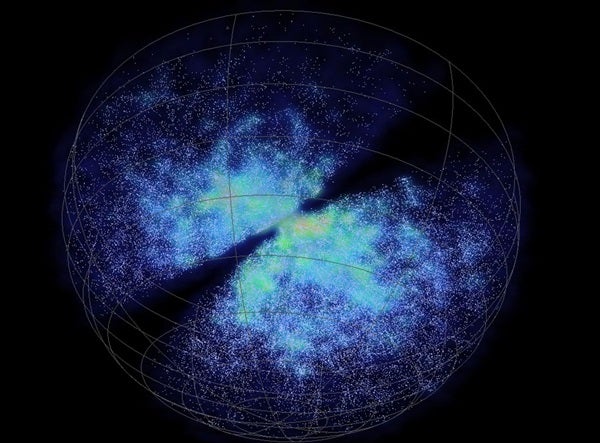The most detailed survey of galaxies in the nearby universe will reveal not only where the galaxies are, but also where they are heading, how fast, and why, according to researchers from Australia, the United Kingdom, and the United States.
Galaxies are tugged around by each other’s gravity. By measuring the galaxies’ movements, the researchers can map the gravitational forces at work in the local universe, and show how matter, seen and unseen, is distributed.
“Light can be obscured, but you can’t hide gravity,” said Heath Jones, lead scientist for the Six-Degree Field Galaxy Survey (6dFGS).
The 6dFGS was carried out with the 1.2-m UK Schmidt Telescope in eastern Australia, operated by the Anglo-Australian Observatory. Broader and shallower than previous comparable surveys — it covered twice as much sky as the Sloan Digital Sky Survey — it has recorded the positions of more than 110,000 galaxies over more than 80 percent of the southern sky, out to about two billion light-years from Earth (a redshift of 0.15).
The survey shows strings and clusters of nearby galaxies on large scales in unprecedented detail, and has revealed more than 500 voids’ apparently empty areas of space with no galaxies.
This survey will let the researchers untangle two causes of galaxy movements.
As well as being pulled on by gravity, galaxies also ride along with the overall expansion of the universe.
For about 10 percent of galaxies, the 6dFGS researchers will tease apart these two velocity components — the one associated with the universe’s expansion, and the one representing a galaxy’s individual, ‘peculiar,’ motion.
There have been previous dedicated peculiar-velocity surveys, but 6dFGS will provide more than five times the peculiar velocities than the largest of these surveys.
Calculating peculiar velocities is done by comparing the galaxy’s distance predicted by its redshift with its distance measured using the galaxy’s internal properties. The technique depends on measuring the width of spectral lines in a galaxy. Doing this accurately needs a high-resolution spectrograph, such as the one built for this survey.
From conception to delivery, the 6dFGS has taken almost a decade. It was made possible by a purpose-built spectrograph and robotic fiber positioner, the Six-Degree Field (6dF) instrument, which allows 150 spectra to be taken simultaneously. The survey also took advantage of the UK Schmidt Telescope’s wide field of view — 5.7°, or 11 times the width of the Full Moon — which was key to the survey being able to cover 80 percent of the southern sky in a reasonable time.
The sample of galaxies was drawn mainly from the 2MASS Extended Source Catalog — they were selected by their infrared light rather than optically selected. Selecting galaxies by their near-infrared (K band) magnitudes avoids bias against galaxies that are currently forming few stars, and instead selects by total stellar mass.










